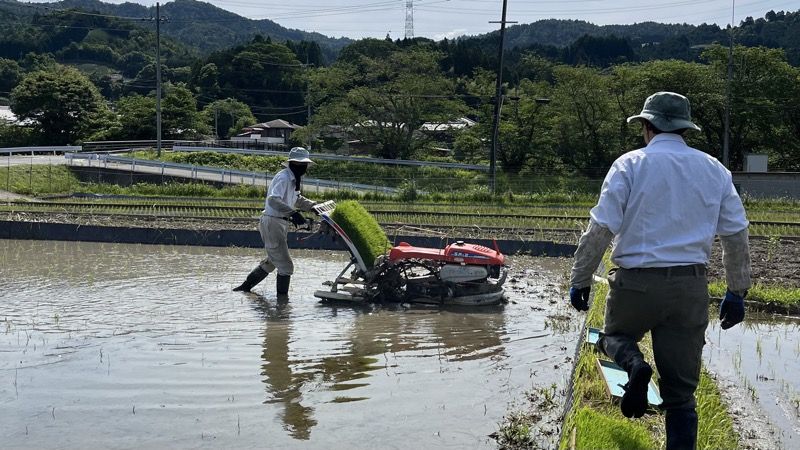After the spring harvest, we had a bit of a downtime from extensive fieldwork like harvesting. Soon after, we switched to farming mode again to prepare for summer harvest and also had the chance to do some deep cut trimming in our somada field, where we harvest our kabuse sencha. Usually, tea bushes get a deep cut trimming every three to four years. This helps to reset the height and shape of the bush, as well as promote a stronger growth in the next period. This deep trimming is commonly performed right after spring harvest, this is because it is such an aggressive cut into the bush that it takes one whole year for the plant to grow back to the previous shape.

Some tea farmers in the village take a break from tea farming during the summer and grow other products like rice. Most of the fall areas in Wazuka are used by buildings and rice paddy. Leaving the tea bushes to grow on the more sloppy terrain. During the summer the rice grows astonishingly fast, first you can see the small bundles of rice in the water, creating a mesmerizing mirror-like reflection at certain times of the day. Then it becomes taller and bright green, and you can see the seas of green blades moving at the tone of the wind. Late summer it ripens, inflating the rice globules with a milky like liquid that will become the rice grain. They slowly turn yellow and golden like, contrasting with the usually green scenery around the village. That is perhaps one of my favorite view around our office, and exactly how the scenery looked when I arrived at Obubu last years September.

 During Summer harvest, the focus shifted towards black tea production. Akky-san produces every year his pine needle wakoucha, one of my favorites, at the same time he produces the summer sun sencha, a tea that packs a punch in terms of texture while retaining great sencha characteristics. During summer, we also did many harvests that will become tencha, the precursor to our culinary grade matcha. Those are perfect for baking and lattes both at home and in cafés. You can find plenty of great recipes made by our interns on our blog, where you can take some inspiration from.
During Summer harvest, the focus shifted towards black tea production. Akky-san produces every year his pine needle wakoucha, one of my favorites, at the same time he produces the summer sun sencha, a tea that packs a punch in terms of texture while retaining great sencha characteristics. During summer, we also did many harvests that will become tencha, the precursor to our culinary grade matcha. Those are perfect for baking and lattes both at home and in cafés. You can find plenty of great recipes made by our interns on our blog, where you can take some inspiration from.
The interns every summer they get the chance to produce their own black tea. Before the actual making we always do a small presentation to give some basic pointers, but the interns are encouraged to experiment and the results are always so interesting to see afterward. In my case, I decided to wither the leaves carefully during the evening by placing them in the cooling containers we use for green tea production. The fans attached to the container can be turned on and off at different time intervals, so I used that function to control the airflow.

Then after putting the tea leaves into the twisting machine, the oxidation process happens much quicker, filling the factory with a fresh green apple smell. I divided the 10 kg of leaves into two 5 kg batches, both went into a double layer plastic bag where I did a light vacuum to promote anaerobic fermentation rather than oxidization with the air. On batch underwent this process for 26 hours before being dried in the oven dryer to stop the process and reduce the moisture to around 5%. The other batch fermented for 16 days, when I opened the bag I remember it smelling like candy or some kind of berry and flowers. This tea was meant to be aged for 2–3 years to let the tea mellow out.

